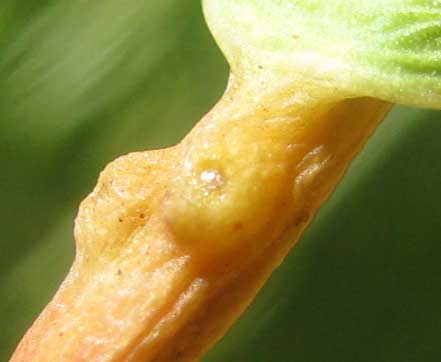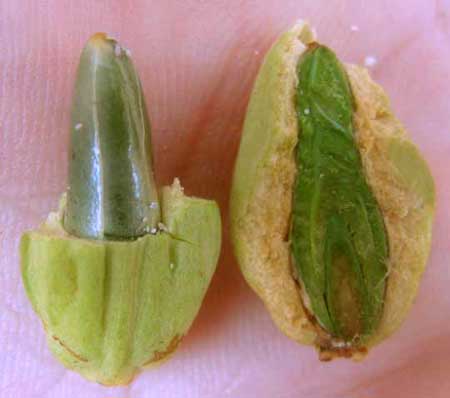

White Mangrove, Laguncularia racemosa, is a member of the mostly tropical Combretum Family. From just a few feet away, dense and much-branching White Mangrove looks like a green wall, but up close you see distinguishing features such as its three-inch-long (7cm) leaves with rounded or notched tips, and long, roundish petioles jutting from the stem almost at right angles. Also there may be clusters of half-inch-long (1.3cm), thick-ribbed, leathery, roughly wedge-shaped fruits.

Atop many of the White Magrove's stiff petioles there are two wartlike glands such as those seen above. In other species such glands often exude chemicals that either attract ants which protect the leaves from leaf eaters, or maybe repel leaf-eating insects. However, White Mangrove's petiole glands help the plant excrete excess salt.
We've seen that Red Mangrove seeds germinate while the fruits still are attached to the stems -- the seeds are "viviparous." With a White Mangrove fruit in hand, I wondered if it might do something similar. A fruit with its top broken off, and another fruit with one side stripped away, is shown below:

The dark green item inside the fruit is the sprout's future green leaves wrapped around one another. In typical seeds we'd find a small, hardly noticeable embryo that would remain dormant for a season but here we have a living shoot that once it's formed never stops developing inside the fruit on or off the tree. This green-leafed shoot will have a head start rooting and growing as soon as the seed is deposited on mud or in water. Since the seeds aren't germinating while still on the tree they're not viviparous like those of the Red Mangrove, but some experts would say that they are "semi-viviparous." Most White Mangroves I see in the Yucatan are only about eight feet tall (2.5m) but I read that they may grow up to 60 feet tall (18m).